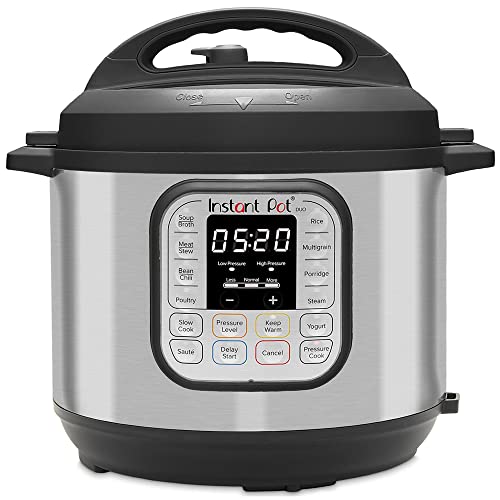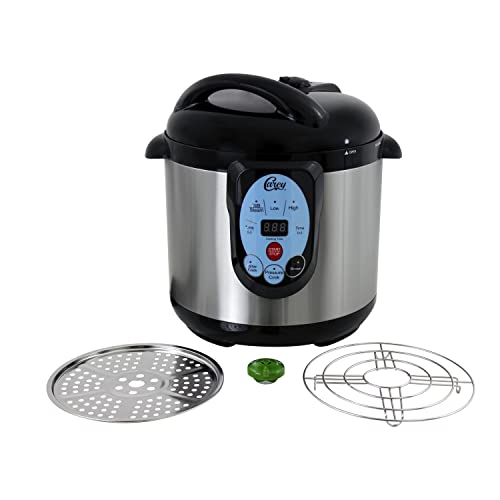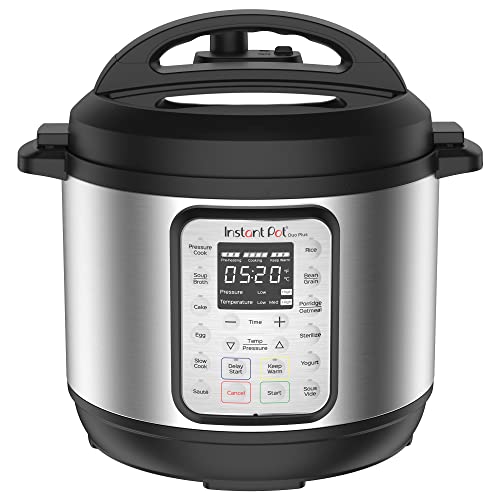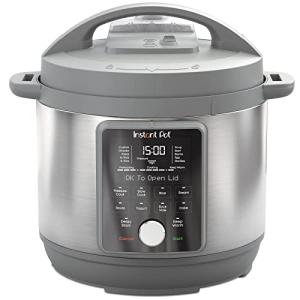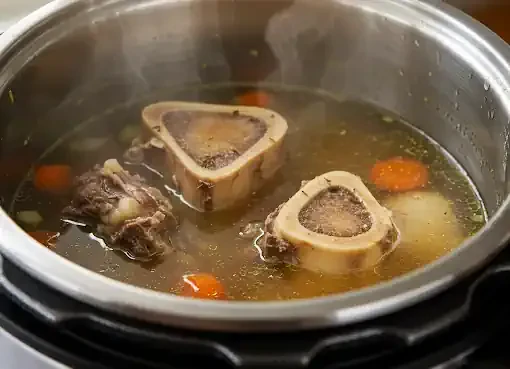Why Pressure Cooker Stew Is A Weeknight Winner
The pressure cooker isn't just a kitchen appliance; it's a weeknight dinner miracle worker. When the clock is ticking and hunger pangs are calling, a hearty stew might seem out of reach. But fear not, because this versatile tool transforms tough cuts of meat and humble veggies into a symphony of flavors faster than you can say "dinner's ready!"
Speed: Dinner Ready In Under An Hour
Gone are the days of slow-simmered stews that demand hours of your precious time. The pressure cooker harnesses the power of steam to create a hot, pressurized environment that tenderizes meat and infuses flavors in a fraction of the time. A dish that once required an afternoon of babysitting can now be on your table in under an hour.
Flavor Infusion: Intense And Rich In Record Time
Not only does the pressure cooker cook faster, but it also intensifies flavors in a way that traditional simmering can't match. The pressurized environment forces liquids and seasonings deep into the ingredients, resulting in a rich, complex taste that will have you wondering how such depth was achieved in such a short amount of time.
Weeknight Versatility: Adaptable To What's In Your Fridge
One of the most appealing aspects of pressure cooker stew is its adaptability. It's a forgiving dish that welcomes whatever you have on hand. Leftover roast? Toss it in! A random assortment of vegetables nearing their expiration date? They'll find a happy home in your stew. The pressure cooker transforms humble ingredients into a culinary masterpiece with minimal effort.
Health Benefits: Nutrient Retention And Less Added Fat
If you're looking for a healthier dinner option, the pressure cooker has your back. The quick cooking time helps preserve more vitamins and minerals in your ingredients compared to longer cooking methods. Plus, the pressure cooker requires less liquid, which means you won't need to add as much oil or butter for flavor, resulting in a lighter, more nutritious meal.
Essential Tools For Pressure Cooker Success
Venturing into the world of pressure cooking requires a few key tools to ensure your culinary journey is both safe and delicious. While the pressure cooker itself is the star of the show, a few accessories and a good understanding of safety procedures are essential for achieving those mouthwatering results you crave.
The Right Pressure Cooker: Electric Vs. Stovetop
The first step is choosing the right pressure cooker for your needs. Electric models, like the popular Instant Pot, offer convenience and a multitude of functions beyond pressure cooking. They typically have preset programs for various dishes, timers, and safety features. On the other hand, stovetop pressure cookers tend to be more budget-friendly and offer more precise control over pressure levels. Consider your cooking style and preferences when making this crucial decision.
Must-Have Accessories: Trivet, Sealing Ring, Extra Gasket
Beyond the cooker itself, a few accessories will elevate your pressure cooking game. A trivet is essential for keeping food above the liquid line, preventing it from burning or becoming mushy. A sealing ring creates an airtight seal, ensuring the pressure builds up properly. And having an extra gasket on hand is a wise move, as they can wear out over time and compromise the cooker's functionality.
Safety First: Pressure Release Methods And Precautions
Safety should always be your top priority when using a pressure cooker. Familiarize yourself with the different pressure release methods: natural release, where pressure gradually subsides on its own, and quick release, where steam is manually released. Understanding when to use each method is crucial for preventing accidents and ensuring your food cooks perfectly.
Cleaning Tips: Easy Maintenance For Your Appliance
Keeping your pressure cooker clean is a breeze. Most parts, like the inner pot and lid, are dishwasher safe. The sealing ring and gasket may require hand washing. Regular cleaning ensures your appliance functions optimally and lasts for years to come.
Choosing The Perfect Stew Meat
The heart and soul of any stew lies in the meat, and selecting the right cut is crucial for achieving tender, flavorful results. With a myriad of options available, it's easy to feel overwhelmed. But fear not, for this guide will help you navigate the butcher's counter with confidence, ensuring your pressure cooker stew is a resounding success.
Best Cuts For Tender Results: Chuck Roast, Short Ribs, Stew Meat
When it comes to pressure cooking, tough cuts of meat are your best friend. Chuck roast, with its marbling of fat, becomes melt-in-your-mouth tender under pressure. Short ribs, known for their rich flavor, also benefit from the pressure cooker's magic touch. Pre-packaged stew meat, often a mix of various cuts, is a convenient option, but be sure to check the quality and fat content for optimal results.
Budget-Friendly Options: Tips For Flavorful Yet Affordable Cuts
Stew doesn't have to break the bank. Look for less expensive cuts like beef shank or oxtail, which become incredibly flavorful and tender when cooked under pressure. Another trick is to buy larger cuts of meat and cube them yourself, saving you money while ensuring the quality of your ingredients.
Grass-Fed Vs. Grain-Fed: Flavor Differences And Considerations
The debate between grass-fed and grain-fed beef rages on, and the choice ultimately comes down to personal preference. Grass-fed beef tends to be leaner and have a slightly gamier flavor, while grain-fed beef is often more marbled and boasts a richer taste. Both can yield delicious results in a pressure cooker stew, so experiment to see which you prefer.
Prepping Your Meat: Cubing, Trimming, And Browning
Before your meat meets the pressure cooker, a little prep work goes a long way. Cut your chosen cut into bite-sized cubes, trimming away excess fat as needed. Browning the meat in a hot pan prior to pressure cooking adds depth of flavor and a beautiful caramelized crust. This step is optional but highly recommended for a truly exceptional stew.
Building Flavor Layers: Vegetables, Herbs, And Spices
While the meat provides a hearty foundation, the vegetables, herbs, and spices are what truly elevate a pressure cooker stew into a symphony of flavors. This is where you can unleash your culinary creativity, experimenting with different combinations to craft a stew that's uniquely yours. Whether you prefer a classic medley of root vegetables or a more adventurous blend of exotic spices, the possibilities are endless.
Classic Stew Vegetables: Potatoes, Carrots, Onions, Celery
The classic quartet of potatoes, carrots, onions, and celery forms the backbone of many beloved stews. Potatoes provide a creamy texture and soak up the surrounding flavors. Carrots lend sweetness and vibrant color. Onions add savory depth, while celery contributes a subtle bitterness that balances the overall taste. These staples are a reliable starting point for any stew, but don't be afraid to venture beyond the familiar.
Flavor Enhancers: Mushrooms, Turnips, Parsnips, Sweet Potatoes
To add complexity and intrigue to your stew, consider incorporating some lesser-known vegetables. Mushrooms offer a meaty texture and earthy notes. Turnips and parsnips contribute a slightly sweet, peppery flavor that complements the richness of the meat. Sweet potatoes introduce a touch of sweetness and vibrant orange hues. These additions can transform a simple stew into a gourmet masterpiece.
Herb And Spice Combinations: Aromatic Blends To Suit Your Taste
The world of herbs and spices is vast and varied, offering endless opportunities for flavor exploration. Classic stew herbs like thyme, rosemary, and bay leaf provide a warm, comforting aroma. For a bolder kick, try adding garlic, ginger, or chili flakes. Experiment with different combinations to find your perfect blend.
Secret Ingredients: Boost Umami With Tomato Paste Or Worcestershire
Umami, the elusive fifth taste, is the secret weapon of many great stews. To enhance this savory depth, consider adding a spoonful of tomato paste or a dash of Worcestershire sauce. These ingredients amplify the meaty flavors and create a more well-rounded taste profile.
Remember, the key to a flavorful stew is layering. Start with the basics and gradually build upon them, adding your chosen vegetables, herbs, and spices at different stages of the cooking process to create a multi-dimensional taste experience.
Mastering The Pressure Cooking Process
Once you've assembled your ingredients, it's time to harness the power of your pressure cooker and transform them into a delectable stew. While the process may seem intimidating at first, it's surprisingly straightforward. With a little guidance and practice, you'll be a pressure cooking pro in no time, confidently creating hearty meals that are both flavorful and efficient.
Sautéing For Depth: Browning Meat And Aromatics
Before sealing the lid and letting the pressure work its magic, take a moment to build a flavor base through sautéing. This step involves browning the cubed meat in a bit of oil to develop a rich, caramelized crust. You can also sauté onions, garlic, and other aromatics to further enhance the depth of flavor. While not strictly necessary, sautéing adds a layer of complexity that elevates your stew to a whole new level.
Liquid Ratios: Broth, Wine, Beer, And Other Flavorful Options
The liquid you choose will significantly impact the final taste of your stew. Beef broth is a classic choice, providing a savory foundation. But don't be afraid to get creative! Red wine adds depth and complexity, while beer lends a malty sweetness. You can even experiment with other flavorful liquids like apple cider or vegetable broth. The key is to use enough liquid to cover the ingredients, but not so much that it dilutes the flavors.
Pressure Cooking Times: Meat, Vegetables, And Overall Cook Time
One of the most common questions in pressure cooking is, "How long do I cook it for?" The answer depends on the type and amount of ingredients you're using. Tough cuts of meat like chuck roast or short ribs may require 30-40 minutes of pressure cooking time, while vegetables like potatoes and carrots typically cook in 5-10 minutes. Refer to a reliable pressure cooking chart or recipe for specific recommendations. Remember, the cooking time starts once the cooker reaches full pressure, not when you begin cooking.
Natural Vs. Quick Release: When To Use Each Method
After the pressure cooking time is complete, you'll have two options for releasing the pressure: natural release or quick release. Natural release involves letting the pressure dissipate on its own, which can take 10-20 minutes. This method is ideal for tougher cuts of meat, as it allows them to rest and become even more tender. Quick release, on the other hand, involves manually releasing the pressure through the steam valve. This is faster but can cause some liquid to splatter, so be cautious. Use quick release for vegetables and dishes that don't require additional resting time.
Thickening And Serving Your Stew
As your pressure cooker stew nears completion, it's time to focus on achieving that perfect hearty consistency and creating a presentation that's as pleasing to the eye as it is to the palate. While the pressure cooker has done most of the heavy lifting, the final touches are crucial for transforming a delicious dish into a truly memorable meal.
Slurry Vs. Roux: Choosing Your Thickener
Thickening your stew is essential for achieving a rich, luscious texture that clings to your spoon. There are two primary methods: using a slurry or a roux. A slurry is a mixture of cornstarch or flour and cold water, whisked together and added to the stew towards the end of the cooking process. It's a quick and easy option that works well for most stews. A roux, on the other hand, is a mixture of butter and flour cooked together to create a paste. It offers a deeper flavor and a silkier texture, but requires an additional step of cooking.
Cornstarch, Flour, Or Alternative Thickeners: Dietary Considerations
If you have dietary restrictions or preferences, there are alternative thickeners available. Arrowroot powder, tapioca starch, or even mashed potatoes can be used to thicken your stew without relying on wheat flour. Experiment with different options to find what works best for your needs.
Serving Suggestions: Crusty Bread, Rice, Noodles, Or Mashed Potatoes
A hearty stew deserves equally satisfying accompaniments. Crusty bread is a classic choice, perfect for sopping up every last drop of flavorful broth. Fluffy rice or noodles offer a comforting base, while creamy mashed potatoes add an extra layer of richness. Choose your side dish based on your personal preference and the overall flavor profile of your stew.
Garnish Ideas: Fresh Herbs, Grated Cheese, Sour Cream, Croutons
The final touch is the garnish, which adds both visual appeal and a burst of flavor. A sprinkle of fresh herbs like parsley, thyme, or chives brightens up the dish and adds a touch of freshness. Grated cheese, such as Parmesan or cheddar, melts into the stew, creating a gooey, satisfying topping. A dollop of sour cream or a handful of crunchy croutons provide contrasting textures that make each bite more enjoyable.
Beyond The Basics: Creative Pressure Cooker Stew Variations
While the classic beef stew is a beloved comfort food, the pressure cooker opens up a world of possibilities for culinary exploration. With its ability to quickly tenderize and infuse flavors, this versatile appliance is the perfect tool for venturing beyond the familiar and creating exciting new stew variations that will tantalize your taste buds.
Global Flavors: Italian, Mexican, Indian, Thai, And More
Take your taste buds on a culinary journey around the world by infusing your pressure cooker stew with global flavors. For a taste of Italy, add tomatoes, oregano, basil, and a splash of red wine. For a Mexican twist, incorporate chili powder, cumin, coriander, and a squeeze of lime. Explore the vibrant flavors of India with garam masala, turmeric, ginger, and coconut milk. Or transport yourself to Thailand with lemongrass, galangal, fish sauce, and a hint of chili heat. The possibilities are endless, so let your imagination run wild.
Vegetarian And Vegan Stews: Hearty And Flavorful Plant-Based Options
Even without meat, pressure cooker stews can be incredibly satisfying and flavorful. Utilize hearty vegetables like butternut squash, lentils, chickpeas, or mushrooms as the base of your stew. Boost the umami factor with miso paste, soy sauce, or nutritional yeast. Add depth and complexity with a variety of spices, herbs, and aromatics. The result is a nourishing, protein-rich meal that's perfect for vegetarians and vegans alike.
Seafood Stews: Utilizing Delicate Fish And Shellfish
The pressure cooker isn't just for beef and vegetables; it's also a fantastic tool for preparing delicate seafood stews. Utilize firm white fish like cod or halibut, or opt for shellfish like shrimp or clams. The key is to add the seafood towards the end of the cooking process to prevent it from becoming rubbery. A light broth made with white wine, lemon juice, and fresh herbs complements the delicate flavors of the seafood beautifully.
Dessert Stews: Unexpected Sweet Treats From Your Pressure Cooker
Who says stews have to be savory? Surprise your guests with a sweet and comforting dessert stew. Combine seasonal fruits like apples, pears, or berries with spices like cinnamon, nutmeg, and cloves. Add a splash of fruit juice or liqueur for extra depth of flavor. The pressure cooker works its magic, transforming the fruit into a tender, saucy compote that's perfect for topping ice cream, yogurt, or pancakes.
Summary
Pressure cooker stew is the perfect weeknight meal, combining speed, flavor, and versatility. Its efficiency makes hearty meals possible in under an hour, with the pressurized environment intensifying flavors and tenderizing meats rapidly. The adaptability of stew welcomes a variety of ingredients, making it a great option for using leftovers or pantry staples. Moreover, pressure cooking retains more nutrients and requires less added fat, offering a healthier alternative to traditional stewing.
Essential for pressure cooking success are the right tools and safety knowledge. Whether electric or stovetop, the pressure cooker itself is the star, but accessories like trivets, sealing rings, and extra gaskets are vital. Understanding pressure release methods and proper cleaning techniques ensures optimal performance and longevity of your appliance.
Choosing the perfect meat is crucial for stew. Tough cuts like chuck roast or short ribs thrive under pressure, yielding tender and flavorful results. Budget-friendly options like beef shank or oxtail also shine. The choice between grass-fed and grain-fed beef is a matter of preference, each offering unique flavor profiles. Proper preparation, including cubing, trimming, and browning, further enhances the final dish.
Vegetables, herbs, and spices build layers of flavor in a stew. Classic options like potatoes, carrots, onions, and celery provide a solid base, while additions like mushrooms, turnips, or sweet potatoes offer complexity. Herbs and spices like thyme, rosemary, garlic, or ginger create aromatic blends tailored to your taste. Secret ingredients like tomato paste or Worcestershire sauce boost umami, adding depth and richness.
Mastering the pressure cooking process involves a few key steps. Sautéing meat and aromatics builds flavor, while choosing the right liquid – broth, wine, beer, or others – adds complexity. Pressure cooking times vary depending on ingredients, but a reliable chart or recipe can guide you. Understanding the difference between natural and quick pressure release ensures optimal results for different dishes.
Thickening and serving are the final touches. Slurries or roux create desired consistency, with alternative thickeners available for dietary needs. Serving suggestions include crusty bread, rice, noodles, or mashed potatoes. Garnishes like fresh herbs, cheese, sour cream, or croutons enhance visual appeal and flavor.
Finally, pressure cooking opens a world of possibilities beyond the classic stew. Explore global flavors, create hearty vegetarian or vegan options, experiment with delicate seafood, or even venture into sweet dessert stews. The pressure cooker's versatility allows for endless culinary creativity and delicious outcomes.

